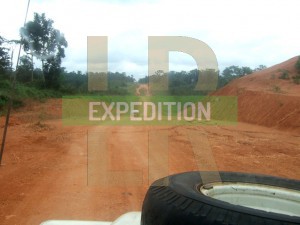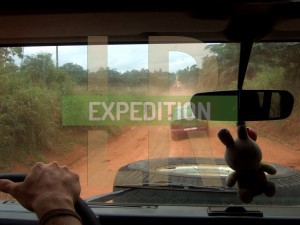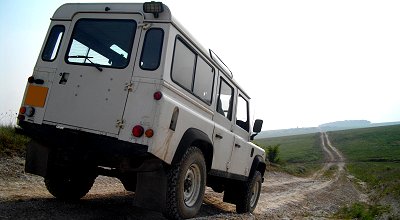Preparing for Expedition conditions on Salisbury plain
I'd been planning on going to Salisbury plain for a long time. It's held in great esteem by off roading communities for its large areas of byways and public access to vehicles. I was expecting a pay and play day mecca, but as it turned out it was rather tame. Where Pay and play days may get to 7/10 on difficulty for a standard vehicle, the plain peaked at around 3/10 with most of it 1 to 2. The fact I went in April after a long dry spell meant there was no mud or water anywhere and would have been a large contributory factor in this.
 But what I did find was a startling and unique experience that took me back to driving a Land Rover in Africa and Central America. Some of the larger thoroughfares are actually graded roads built by the military, and the rest are long sweeping or rutted tracks. In all it was very exemplary of the type of roads found around the less developed parts of the world - constructed, but unsealed.
But what I did find was a startling and unique experience that took me back to driving a Land Rover in Africa and Central America. Some of the larger thoroughfares are actually graded roads built by the military, and the rest are long sweeping or rutted tracks. In all it was very exemplary of the type of roads found around the less developed parts of the world - constructed, but unsealed.
I sensed a great opportunity to be able to hone the skills of the Expedition Land Rover driver in life-like circumstances. I firmly believe that the most important factor that makes a vehicle the best 4x4 in the world is the driver. In that article I presented three points that I believe are the aim of the expedition driver (Don’t get stuck, Don’t damage the vehicle, Don’t make your passengers uncomfortable). The first two are used in scenarios that lead you to try your skills at relatively low speed, normally due to an inherent obstacle in the road - a patch of mud or rocky terrain. These circumstances would either suck you up to the arches or smash open a differential. The third aspect can loosely be translated as "Don't crash", and relates to the likelyhood of relative high speed on fairly well constructed, but loose-surface roads.
 The first two aspects can be trained in Pay and Play days, and may result in temporary, fixable and albeit annoying consternation. The latter is indicative of the main proportion of a journey overseas and the odds of being involved in a rollover or a collision are a lot higher. Naturally, this could end up finishing your expedition for good (or worse). This third aspect is something I learnt on the job, as does everyone else who goes on expeditions, but I think for a bit of practise on Salisbury Plain you can learn how your vehicle handles in these type of "in-country" conditions. In the UK this type of experience is not as readily expected or publicised as the "glamarous" mud plugging, but could end up keeping yourself and others safe.
The first two aspects can be trained in Pay and Play days, and may result in temporary, fixable and albeit annoying consternation. The latter is indicative of the main proportion of a journey overseas and the odds of being involved in a rollover or a collision are a lot higher. Naturally, this could end up finishing your expedition for good (or worse). This third aspect is something I learnt on the job, as does everyone else who goes on expeditions, but I think for a bit of practise on Salisbury Plain you can learn how your vehicle handles in these type of "in-country" conditions. In the UK this type of experience is not as readily expected or publicised as the "glamarous" mud plugging, but could end up keeping yourself and others safe.
Hold on. Isn't a dirt road just a normal road but bumpier and muddier?!?
The underestimation
Part of the reason why I think getting a bit of practise is a good thing is because you start with a naive belief that a dirt road is similar to a metalled road - just that it's dustier and rougher. In reality, dirt roads are susceptible to a large amount of environmental factors, which can change their surface almost on a daily basis. The road becomes a dynamic creature. Whilst a pay and play site will be a thronging mash of mud and water in every direction and the obstacles are obvious, unsealed roads meander through the terrain with many hidden features. This has an innate ability to catch drivers from the developed world off guard because we're not used to it.
Characteristics of unsealed roads
So what's different about an unsealed road?
Potholes at bottom and tops of hills - Water pools where the road is flat. Wheels hitting wet patches erode into pot holes. These tend to form with regularity at the bottom of an incline, as you flatten out after ascending an incline and vice versa for descent. And it's not just a couple, but usually quite a few in close proximity. Hitting a patch of pot holes at speed will make your wheels jump about sideways and induce brown trousers as you head for the verge.
 Single track on a two way road - Everyone drives in the easiest line of attack, so whilst a road may be wide enough for two cars, there will usually be only one good route. Naturally, anything you meet coming towards you will be in the same tracks. Pulling over to let someone pass results in you feeling the wrath of the untamed edges of the road that haven't been driven much.
Single track on a two way road - Everyone drives in the easiest line of attack, so whilst a road may be wide enough for two cars, there will usually be only one good route. Naturally, anything you meet coming towards you will be in the same tracks. Pulling over to let someone pass results in you feeling the wrath of the untamed edges of the road that haven't been driven much.
Corrugations - A peculiar effect that creates a "washboard" surface on the road particularly where the surface is dry and people drive fast. There's no conclusive evidence on what exactly creates them, suffice to say they will form like a mystical phenomenon.
 Drainage gullies on hills - Water goes downhill. If it has rained hard enough the water will follow the route of the road and it starts to wash away and create gullies. This can cause loss of traction uphill and a great deal of body roll.
Drainage gullies on hills - Water goes downhill. If it has rained hard enough the water will follow the route of the road and it starts to wash away and create gullies. This can cause loss of traction uphill and a great deal of body roll.
Bad corrugations on cambered bends - Similar to the drainage gullies, the slope of the road on a cambered bend is perpendicular the direction of travel, so the water flows across the road creating sometimes large gullies on the inside of the bend where the slope is steepest. This means that most people drive on the outside edge creating the single track effect where the corrugations are smaller.
 Pedestrians - In many parts of the world, the road is the main thoroughfare for all transport including walkers and cyclists. If you go to a poorer area, they are likely to be the majority of road traffic. Needless to say they can be the most unexpected hazard as there is no pavement and they may be in the middle of the road.
Pedestrians - In many parts of the world, the road is the main thoroughfare for all transport including walkers and cyclists. If you go to a poorer area, they are likely to be the majority of road traffic. Needless to say they can be the most unexpected hazard as there is no pavement and they may be in the middle of the road.
Tracks at the edge - The pot holes on flat sections of road tend to congregate in the middle. The traffic then moves to the edges where it's a bit smoother, but the risk is higher as the road tends to camber off and it is all too easy for a wheel to slip into the undergrowth. And there may still be a pot hole that appears from nowhere at the edge.
The list is by no means a exhaustive, but I have encountered these features with such regularity that I have been able to formulate this list. I expect these hazards as I travel further along a road and am now able to recognise the particular conditions that lead to their formation. Experience of these conditions is the sort of thing that you can get on Salisbury Plain. So how can these conditions be taken into account to make yourself a better driver on expedition?
Learning point 1: Pot holed sections
It may sound silly, but with the mindset that drivers in the UK and probably other developed countries have, we can't avoid things that well. We don't come across pot holes very often (if the council's on the ball), and our roads are normally flat and smooth; free of obstructions and wayward items. We literally don't have the experience to be able to cope with obstacles that appear erratically.
Following a harsh winter when the pot holes start to emerge, they begin to escalate quickly in area and depth. People always complain because they're damaging their vehicles. But because we have a road system where everything is nice and smooth, we just hit the pot holes because either we don't think of them or we just don't bother avoiding them. So everyone hits the pot holes, because everyone follows the same lines on a bend or junction and they get worse - really quickly. The simple answer is to drive around them, but this in fact take a lot of brain power because you're naturally following in the tracks of the car in front.
These days, I always try to avoid them as driving practise. My first drive on a bad road in Belize was a nightmare of being shaken to death. At first it was hard to consciously drive around them. Now I can't stand being driven in a car that hits pot holes. They seem so easy to avoid. It's a habit you need to learn.
On expedition you have to learn that habit quickly. If you hit every pot hole in the road you'll end up with a headache and clanging bit of metal hanging off your Land Rover!
Learning point 2: Being prepared to stop
 Another thing about bad roads is that it may be fine on the bit you're driving on, but just around the corner there may be a massive area of pot holes or another obstruction. This is why its important to take things easy and not to speed. If UK motorways had a massive pot hole every mile - you wouldn't drive at 70mph. When planning a route it's a hard thing to factor in when you think "There's a 50 mile road between A and B, so i'll drive at 50mph and be there in an hour". In the UK, fine (depending on traffic); in the middle of Africa that road will snake through every village along the way, will probably be used by pedestrians and cyclists, and be covered in pot holes.
Another thing about bad roads is that it may be fine on the bit you're driving on, but just around the corner there may be a massive area of pot holes or another obstruction. This is why its important to take things easy and not to speed. If UK motorways had a massive pot hole every mile - you wouldn't drive at 70mph. When planning a route it's a hard thing to factor in when you think "There's a 50 mile road between A and B, so i'll drive at 50mph and be there in an hour". In the UK, fine (depending on traffic); in the middle of Africa that road will snake through every village along the way, will probably be used by pedestrians and cyclists, and be covered in pot holes.
Driving these roads is tiring because you're always on edge that something may lurk up in front of you. You may get a long straight section where you feel you can speed up a bit, but you may come across a huge pot hole that makes you brake harshly. Invariably if you were being cocky and going too fast you end up braking as you hit the pothole at speed and almost hit the roof. Any passengers will give you a scowl before you sheepishly move off again. Accepting that you won't make the progress you initially assumed will help you take things at a slower, safer and more comfortable pace.
Learning point 3: Not speeding up before a hill
It's only natural (particularly in a Defender!) that when you see a hill you accelerate a bit to carry you on through more easily. On bad roads, you find yourself coming up against the second characteristic listed above. The bottoms of slopes are where the majority of pot holes occur, so to hit the hill at speed you'll have to make your way through these - and they generally stretch the whole width of the road. Accepting that you'll probably have to take most hills in second gear will help you stay on the road.
Because hills can also have deep drainage gullies, the vehicle can also rock side to side quite viscously if you hit it at speed, so it's important to be able to pick your line carefully by taking your time.
Learning point 4: Taking steeply cambered bends with care
 The run off of water will create ruts perpendicular to your line of travel. This means you'll be hitting potentially several large bumps in quick succession on a corner, which could make you under-steer and send you off the road. The local practice is therefore to drive on the outside of the bend where the road is flatter, so there is a very real chance of a vehicle coming the other way. Bear this in mind if you choose to take this line. It therefore becomes very important to take cambered and/or blind bends at low speed.
The run off of water will create ruts perpendicular to your line of travel. This means you'll be hitting potentially several large bumps in quick succession on a corner, which could make you under-steer and send you off the road. The local practice is therefore to drive on the outside of the bend where the road is flatter, so there is a very real chance of a vehicle coming the other way. Bear this in mind if you choose to take this line. It therefore becomes very important to take cambered and/or blind bends at low speed.
Learning point 5: Corrugations
They're a menace and make the vehicle very skittish, but are best driven at about 50-60kph, as you'll find that the shaking of the vehicle reaches a harmonic balance and the noise reduced to a light thronging. Your shock absorbers and suspension will be taking a battering though so may not last long with these roads! This is exactly the sort of roads that would lend itself to dual rear shock absorbers or a good quality single shock absorber.
Learning point 6: Dust
 Dust comes and goes as the road surface changes. The shut lines on Defenders are crap at keeping dust out, so it's best to keep your distance behind any preceding vehicle to prevent getting a lungful of dust and also so you can see in front of you more easily. The aerodynamic drag on a vehicle increases exponentially with speed, so if you double the speed, you quadruple the drag. This means you suck up more and more dust from the road the faster you go. This may be particularly useful to keep in mind if driving in convoy. Your air filter will love a snorkel in these conditions.
Dust comes and goes as the road surface changes. The shut lines on Defenders are crap at keeping dust out, so it's best to keep your distance behind any preceding vehicle to prevent getting a lungful of dust and also so you can see in front of you more easily. The aerodynamic drag on a vehicle increases exponentially with speed, so if you double the speed, you quadruple the drag. This means you suck up more and more dust from the road the faster you go. This may be particularly useful to keep in mind if driving in convoy. Your air filter will love a snorkel in these conditions.
Conclusion
These are the things i've learnt from driving on unsealed roads around the world. I learnt it the hard way through first hand experience and it's certainly best if you can too. Having seen the kinds of similar conditions that Salisbury plain can provide, I would say that taking a trip there to experience the handling of your Land Rover (preferably kitted out at full weight) would be a great learning experience. To see how it handles away from the plodding speeds of greenlanes and pay and play sites will pay off in the end, seeing as most driving on expedition (away from tar) would be on unsealed roads rather than off road tracks. Forewarned is forearmed!
Here's a video to show a bit more of what i'm talking about. There is no sound (grr):
